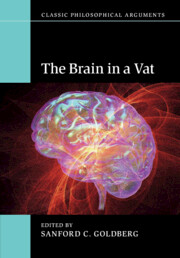Book contents
- Frontmatter
- Contents
- List of contributors
- Acknowledgments
- 1 Introduction: Putnam's reflections on the brain in a vat
- Part I Intentionality and the philosophy of mind and language
- 2 Putnam on brains in a vat
- 3 How to think about whether we are brains in vats
- 4 Brains in vats, causal constraints on reference and semantic externalism
- 5 Extended minds in vats
- Part II Epistemology
- Part III Metaphysics
- Bibliography
- Index
4 - Brains in vats, causal constraints on reference and semantic externalism
from Part I - Intentionality and the philosophy of mind and language
Published online by Cambridge University Press: 05 June 2016
- Frontmatter
- Contents
- List of contributors
- Acknowledgments
- 1 Introduction: Putnam's reflections on the brain in a vat
- Part I Intentionality and the philosophy of mind and language
- 2 Putnam on brains in a vat
- 3 How to think about whether we are brains in vats
- 4 Brains in vats, causal constraints on reference and semantic externalism
- 5 Extended minds in vats
- Part II Epistemology
- Part III Metaphysics
- Bibliography
- Index
Summary
Putnam's proof (1981b) that we are not brains in vats (BIVs) is often construed as a semantic response to epistemological skepticism. In particular, the proof has typically been assumed to rely on semantic externalism, that is, the view that the semantic contents of referring terms depend on features of the external environment in a constitutive sense. This chapter provides a critical assessment of that assumption. Crucially, all that the best formulation of the proof relies on is a causal constraint on reference, which should be distinguished from a causal theory of reference. Some semantic internalists accept such a constraint in virtue of combining their view with the claim that reference is determined by satisfaction of causal descriptions. It turns out the semantic content of such descriptions constitutively depends neither on internal features of speakers nor on the sorts of environmental features which semantic externalists typically point to. So, if semantic externalists can appeal to Putnam's proof as a semantic response to epistemological skepticism, then so can those semantic internalists who endorse causal descriptivism.
Reference and causation
Putnam (1981b: 5ff.) argued that words do not intrinsically represent what they are about. For instance, ‘Churchill’ and ‘squirrel’ do not by themselves represent the individual Churchill and the species sciurus vulgaris, respectively. At least two conditions must be met if a word is to play a representational role. First, a word can represent an object or a natural kind only when used by an individual (S) with the intention of representing an object or a natural kind. If an ant crawling in the sand accidentally draws a picture of Churchill, it does not succeed in representing Churchill because it does not intend the indentation to represent Churchill. Secondly, a word is capable of representing an object or a natural kind in the external world only if appropriate causal connections are in place between S using that word and the relevant object or instances of the relevant kind. Our ant on the beach sustains no causal connections whatsoever with Churchill. Putnam takes representational intention and causal connection to be individually necessary for S to use a word to successfully represent an object or a natural kind. Whether these conditions should also be regarded as jointly sufficient is neither a question Putnam addresses nor one that we shall settle here. On the face of it, the first condition seems highly plausible.
- Type
- Chapter
- Information
- The Brain in a Vat , pp. 37 - 53Publisher: Cambridge University PressPrint publication year: 2016



